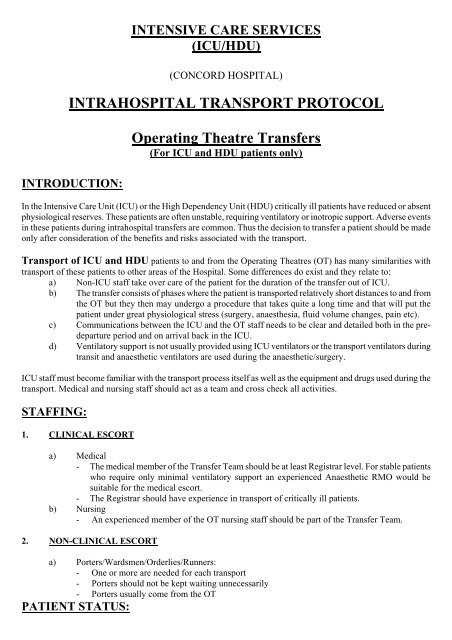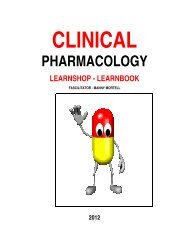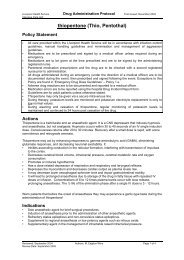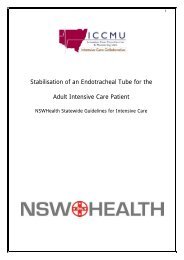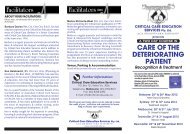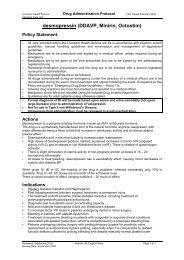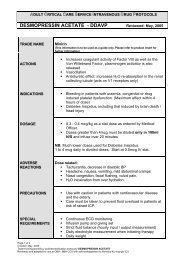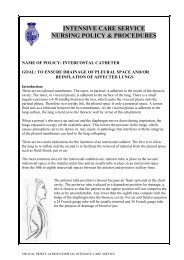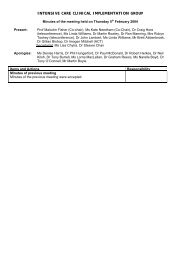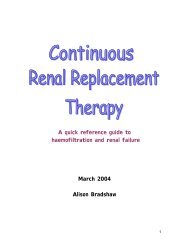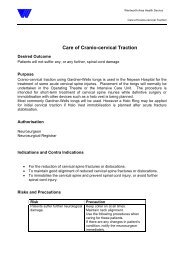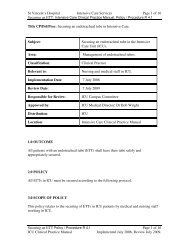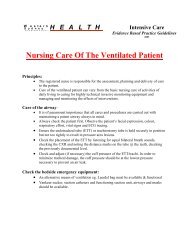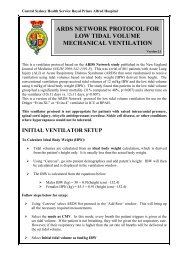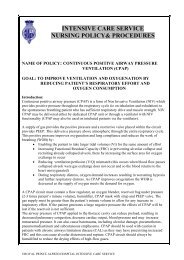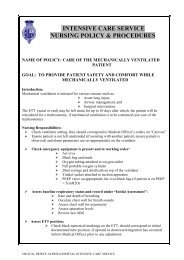icu transport protocol - Intensive Care & Coordination Monitoring Unit
icu transport protocol - Intensive Care & Coordination Monitoring Unit
icu transport protocol - Intensive Care & Coordination Monitoring Unit
Create successful ePaper yourself
Turn your PDF publications into a flip-book with our unique Google optimized e-Paper software.
INTENSIVE CARE SERVICES<br />
(ICU/HDU)<br />
(CONCORD HOSPITAL)<br />
INTRAHOSPITAL TRANSPORT PROTOCOL<br />
INTRODUCTION:<br />
Operating Theatre Transfers<br />
(For ICU and HDU patients only)<br />
In the <strong>Intensive</strong> <strong>Care</strong> <strong>Unit</strong> (ICU) or the High Dependency <strong>Unit</strong> (HDU) critically ill patients have reduced or absent<br />
physiological reserves. These patients are often unstable, requiring ventilatory or inotropic support. Adverse events<br />
in these patients during intrahospital transfers are common. Thus the decision to transfer a patient should be made<br />
only after consideration of the benefits and risks associated with the <strong>transport</strong>.<br />
Transport of ICU and HDU patients to and from the Operating Theatres (OT) has many similarities with<br />
<strong>transport</strong> of these patients to other areas of the Hospital. Some differences do exist and they relate to:<br />
a) Non-ICU staff take over care of the patient for the duration of the transfer out of ICU.<br />
b) The transfer consists of phases where the patient is <strong>transport</strong>ed relatively short distances to and from<br />
the OT but they then may undergo a procedure that takes quite a long time and that will put the<br />
patient under great physiological stress (surgery, anaesthesia, fluid volume changes, pain etc).<br />
c) Communications between the ICU and the OT staff needs to be clear and detailed both in the predeparture<br />
period and on arrival back in the ICU.<br />
d) Ventilatory support is not usually provided using ICU ventilators or the <strong>transport</strong> ventilators during<br />
transit and anaesthetic ventilators are used during the anaesthetic/surgery.<br />
ICU staff must become familiar with the <strong>transport</strong> process itself as well as the equipment and drugs used during the<br />
<strong>transport</strong>. Medical and nursing staff should act as a team and cross check all activities.<br />
STAFFING:<br />
1. CLINICAL ESCORT<br />
a) Medical<br />
- The medical member of the Transfer Team should be at least Registrar level. For stable patients<br />
who require only minimal ventilatory support an experienced Anaesthetic RMO would be<br />
suitable for the medical escort.<br />
- The Registrar should have experience in <strong>transport</strong> of critically ill patients.<br />
b) Nursing<br />
- An experienced member of the OT nursing staff should be part of the Transfer Team.<br />
2. NON-CLINICAL ESCORT<br />
a) Porters/Wardsmen/Orderlies/Runners:<br />
- One or more are needed for each <strong>transport</strong><br />
- Porters should not be kept waiting unnecessarily<br />
- Porters usually come from the OT<br />
PATIENT STATUS:
1. As stated above, the benefit of the proposed intervention should outweigh the risk of moving the critically<br />
ill patient.<br />
2. Patients who require an FiO2 equal to or more than 0.40 and/or CPAP equal to or more than 10 cmH2O will<br />
require assisted ventilation using the Laerdal self-inflating resuscitator and the CPAP connector and an<br />
appropriate CPAP valve. (It is recommended that ventilatory support settings be increased during the<br />
transfer eg CPAP 10 to CPAP 12.5).<br />
EQUIPMENT:<br />
a) General:<br />
All staff must be familiar with each item of equipment. All equipment must be prepared and<br />
checked prior to the transfer. All electrical items must be fully charged. Power cords and/or<br />
rechargers should be taken in case there is a delay in the transfer. Whenever stationary, plug into<br />
power outlets and connect to wall oxygen.<br />
Staff should check prior to any transfers that any destination environment will support the level of<br />
care required for the patient. This includes O2 and suction outlets as well as a safe electricity supply.<br />
Equipment used in the transfer should be stowed safely and not placed on the patient. Staff need to<br />
familiarise themselves with the location of the disposable and non-disposable equipment within the<br />
ICU/HDU.<br />
b) Specific items:<br />
i) Oxygen cylinders (two)<br />
ii) Portable Monitor (including ETCO2 where deemed necessary)<br />
iii) Transport Box: check contents of the box<br />
iv) Laerdal Resuscitator:<br />
• The Resuscitator is kept sterile in the white container or sealed sterile cover until use<br />
o Resuscitator<br />
o CPAP attachment (expiratory and connector)<br />
o Masks<br />
• Resuscitator attachments are stored in one of the Maxibins<br />
o 10" disposable circuit tubing<br />
o Green O2 tubing<br />
o Disposable Portex Thermovent 1200 Patient Filter<br />
o 2L black bag as a “dummy” lung<br />
• approach set up by checking main unit first then check CPAP attachment then join the two<br />
• MAIN UNIT<br />
o Assemble correctly with all valves in place<br />
o Attach green tubing to O2 inlet<br />
o Check function NB: use 2L black bag as a “dummy” lung<br />
• CPAP ATTACHMENT<br />
o Laerdal CPAP unit<br />
o 10" disposable circuit tubing<br />
o CPAP valve – disposable; level of CPAP (cmH2O) 5, 7.5, 10. 12.5, 15, 20<br />
o Attach to the main unit and check function of whole assembly.<br />
TRANSPORT PROCEDURE :
a) Pre-transfer:<br />
i) Patient:<br />
a. Appropriateness: patients on significant respiratory and/or significant inotropic<br />
support or are otherwise unstable should not considered suitable for intra hospital<br />
<strong>transport</strong>; exceptions can be made if the reason for the <strong>transport</strong> is deemed<br />
absolutely necessary;<br />
b. Review current stability<br />
c. Check cardiovascular support<br />
o current parameters<br />
o need for inotropes<br />
o check line placement(s) and security<br />
o identify line for dedicated IV access during <strong>transport</strong><br />
d. Check ventilation parameters<br />
o check ETT for placement and security<br />
o ensure recent suction has been carried out<br />
o check recent ABG<br />
o because patients will be lying supine and/or will be in transit for lengthy periods<br />
of time it is recommended that the CPAP settings be increased and/or PS<br />
ventilation is added or the level increased<br />
ii) Equipment: use tray below the bed to store resuscitator, Transport Box etc.<br />
a. Check:<br />
o O2 cylinders / Transport Box<br />
o Laerdal resuscitator<br />
o infusion/syringe pumps/spare power cords<br />
o IV poles for bed<br />
o BED: can be raised and lowered, head up and head down, power cord is to<br />
go on transfer<br />
o Remove unnecessary equipment - e.g. mattress pump, calf compression<br />
o NB: FOR PATIENTS GOING FOR TRACHEOSTOMY, in<br />
general one or more appropriately sized Mallinckrodt<br />
Tracheostomy tube will be sent with the patient; the OT transfer<br />
Team (in part<strong>icu</strong>lar the Doctor) has the responsibility of ensuring<br />
that the surgical team insert the tracheostomy tube that is sent<br />
with the patient.<br />
b. carry appropriate support drugs:<br />
o sedation<br />
o vasoactive drugs<br />
o IV fluids<br />
o carry any drugs that may need to be given while away from the ICU e.g.<br />
antibiotics; patients on inotrope infusions should have an additional pre-loaded<br />
syringe available;<br />
iii) Documentation:<br />
a. Consent<br />
b. Imaging films<br />
c. Patient notes<br />
iv) Communications:<br />
a. It is imperative that all aspects of the patient’s current status are conveyed to the OT
Transfer Team.<br />
b. Information to be conveyed to the OT Transfer Team should at least include:<br />
i. Current stability<br />
ii. Need for antibiotics<br />
iii. Ventilation requirements<br />
iv. Infection control status<br />
v. Specific information eg chest drains, tracheostomy recommendations<br />
b) In the Operating Theatre:<br />
i) Wear gowns and gloves at all times and eye protection when deemed necessary; patients<br />
infected or colonised with epidemiologically significant organisms (eg MRSA, MR<br />
Acinetobacter, MR pseudomonas etc) should be transferred using the current infection<br />
control practices (i.e. contact barrier precautions). All attempts should be made to minimise<br />
the risk of transfer of these organisms to the OT environment.<br />
ii) Stay with patient at all times<br />
iii) Continuously monitor: ventilation and respiratory parameters<br />
cardiovascular parameters<br />
iv) All activities associated with the patient during their time in the OT should be documented<br />
c) Post-transfer:<br />
1. Patient stabilisation:<br />
i) Ensure the patient is connected to the bedside ventilator and monitor<br />
ii) Check stability of the patient: clinical examination and ABG and CXR<br />
iii) Document the patient’s condition before, during and after the transfer<br />
2. Handover:<br />
i) The OT Transfer Team must ensure that the patient is stabilised before they leave<br />
ii) The OT Transfer Team must handover the patient to both the ICU medical and nursing staff<br />
iii) The medical member of the OT Transfer Team will call ahead to the ICU and indicate an<br />
estimated time of arrival back in the ICU. The ICU staff must make themselves available to<br />
take the handover from the OT staff.<br />
iv) The medical member of the OT Transfer Team must handover to one of the ICU medical<br />
team (in-hours this must be one of the registrars, out-of-hours it is preferable to handover to<br />
a registrar but this may not be possible).<br />
3. Other:<br />
i) Any drugs that were drawn up in syringes for the transfer must be now discarded.<br />
ii) Clean all non-disposable equipment including power cords<br />
November 2003


